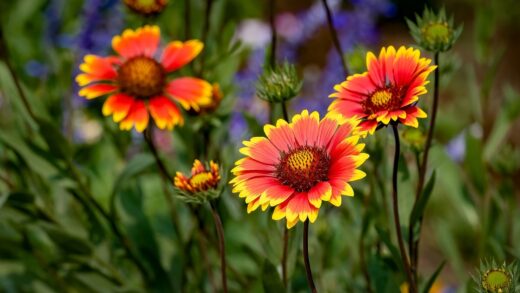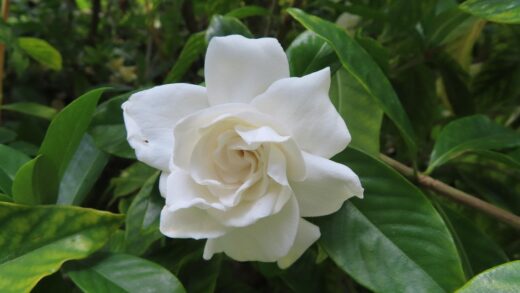Understanding the precise water needs of bluebeard is fundamental to cultivating a healthy, vibrant shrub that rewards you with a profusion of late-season blooms. While it is renowned for its impressive drought tolerance once established, this characteristic can sometimes mislead gardeners into thinking it requires no water at all. The reality is more nuanced, involving a careful balance of providing sufficient moisture during its establishment phase and then adopting a more hands-off approach as it matures. Mastering the art of irrigation for this plant means recognizing the signs of both thirst and over-saturation.
The key to its drought resistance lies in the plant’s root system, which, when properly encouraged, grows deep into the soil profile to access moisture reserves unavailable at the surface. This is why the watering practices you employ during the first year are so critical. By watering deeply and infrequently, you train the roots to grow downward in search of water, building a resilient foundation for the plant’s future. This contrasts sharply with shallow, frequent watering, which encourages a weak, surface-level root system that is highly vulnerable to heat and drought.
Once mature, bluebeard’s water requirements are remarkably low, making it an exemplary choice for sustainable, water-wise gardening. In many climates with regular summer rainfall, an established shrub may require no supplemental irrigation at all. However, during extended periods of high heat and no rain, even the most drought-tolerant plants will benefit from an occasional deep soaking. Learning to read the plant’s subtle cues, such as a slight drooping of the leaves in the afternoon that doesn’t recover by evening, will tell you when it is time to intervene.
The consequences of improper watering, particularly overwatering, are far more severe for bluebeard than underwatering. The plant has a strong aversion to “wet feet,” and constantly saturated soil will quickly lead to the development of fatal root rot diseases. This is why soil drainage is invariably emphasized as the most critical factor in its cultivation. Your irrigation strategy must always be considered in conjunction with the quality of your soil; a plant in sandy, fast-draining soil will need water more often than the same plant in a heavier loam.
Understanding bluebeard’s drought tolerance
The remarkable drought tolerance of an established bluebeard shrub is one of its most celebrated attributes. This resilience is not accidental but is a feature of its adaptation to environments with lean, well-drained soils and periods of low rainfall. The plant’s physiology is geared towards conserving water, with its somewhat narrow, often grayish leaves reducing the surface area for transpiration, the process of water evaporating from the foliage. This efficiency allows the plant to thrive in conditions that would cause many other garden shrubs to wilt and fail.
More articles on this topic
This inherent tolerance develops as the plant matures. During its first year in the garden, a bluebeard is not yet drought-tolerant and requires consistent moisture to build the extensive root system that will sustain it in the future. As the roots penetrate deeper into the soil, they gain access to more reliable moisture sources, making the plant less dependent on surface water from rain or irrigation. It is this deep and well-established root network that is the true source of its ability to withstand dry spells. Therefore, patience and proper care in the first season are essential for unlocking this low-maintenance characteristic.
It is important to understand that drought tolerance does not mean the plant can survive indefinitely without water. In periods of extreme and prolonged drought, especially when combined with high temperatures, even a mature bluebeard will experience stress. This stress may manifest as leaf drop, a cessation of blooming, or even branch dieback. While the plant may survive, its ornamental quality will be greatly diminished. Providing a deep watering once every few weeks during such severe conditions will help it endure the stress and recover more quickly when conditions improve.
Ultimately, the goal is to create a self-sufficient plant that thrives with minimal intervention. By choosing a sunny site with excellent drainage and encouraging deep root growth through proper watering techniques early on, you can cultivate a bluebeard that truly lives up to its reputation. This makes it an ideal plant for xeriscaping, low-maintenance borders, and any garden where water conservation is a priority. The ability to provide stunning floral displays with very little supplemental water is what makes bluebeard such a valuable and sustainable choice for the modern garden.
Watering newly planted shrubs
The first growing season is a critical period for any newly planted shrub, and bluebeard is no exception. During this time, the plant’s primary focus is on establishing a strong and healthy root system, which will be the foundation for its future growth and drought tolerance. To support this process, you must provide consistent and adequate moisture. The goal is to keep the soil around the root ball evenly moist but never waterlogged. This typically translates to a deep watering once or twice per week, depending on your climate and soil type.
More articles on this topic
A reliable way to determine if it’s time to water is to check the soil with your finger. Insert your finger about five to seven centimeters deep into the soil near the base of the plant. If the soil feels dry at that depth, it is time to provide a thorough watering. If it still feels moist, you can wait a few more days before checking again. This simple method is more accurate than watering on a fixed schedule, as it accounts for variations in weather and temperature that affect how quickly the soil dries out.
When you do water, it is crucial to do so deeply. A light sprinkling that only wets the surface of the soil is ineffective and can encourage the development of a shallow root system. Instead, apply water slowly and directly to the base of the plant, allowing it to soak deep into the ground. A soaker hose or a hose turned on to a slow trickle and left in place for 20-30 minutes is an excellent way to achieve this deep watering. This ensures that the entire root zone is hydrated, encouraging the roots to grow downward.
As the season progresses and the plant becomes more established, you can gradually begin to reduce the frequency of watering. By late summer and early autumn, the plant will have developed a more substantial root system and will be less dependent on frequent irrigation. This gradual weaning process helps the plant transition towards the drought-tolerant state it will maintain as a mature shrub. Continuing to monitor the soil moisture and the plant’s appearance will guide you in making these adjustments effectively.
Irrigation during the growing season
For a mature and well-established bluebeard, irrigation during the growing season is a matter of strategic intervention rather than a regular chore. In regions that receive occasional summer rainfall, you may find that you rarely need to provide supplemental water. The plant is adept at sourcing the moisture it needs from the soil, especially if it has been encouraged to develop a deep root system. Your role becomes that of an observer, ready to step in only when nature isn’t providing enough to sustain the plant through a dry spell.
The best indicator that an established bluebeard needs water is the condition of its foliage during the hottest part of the day. It is normal for many plants, including bluebeard, to show some minor wilting in the afternoon heat as a way to conserve moisture. However, if the leaves are still drooping in the cooler temperatures of the evening or the following morning, it is a clear sign that the plant is experiencing water stress and would benefit from a deep soaking. This is a much more reliable indicator than simply looking at the soil surface, which can be dry even when moisture is present deeper down.
When supplemental watering is necessary for an established plant, the principle of “deep and infrequent” remains paramount. A single, thorough irrigation that saturates the root zone is far more beneficial than several light applications. This deep watering replenishes the moisture reserves deep in the soil profile, where the majority of the plant’s roots are located. For a mature shrub, this might mean letting a hose run slowly at its base for a significant period, ensuring the water penetrates at least 30 centimeters into the ground.
During the peak flowering period in late summer and autumn, ensuring the plant is not under severe water stress can help to prolong the bloom time and maintain the vibrancy of the flowers. While the plant will still flower under dry conditions, the display will be more robust and longer-lasting if it is not struggling for survival. A single deep watering just as the buds begin to form can provide the necessary resources for a truly spectacular floral show, reinforcing that even the most drought-tolerant plants appreciate a drink during key stages of their growth cycle.
Signs of overwatering and underwatering
Learning to distinguish between the signs of overwatering and underwatering is a crucial skill for any gardener, especially when dealing with a plant like bluebeard that is sensitive to excess moisture. The most common and dangerous issue is overwatering, which leads to root rot. The initial symptoms can be surprisingly similar to underwatering, including wilting of the leaves. However, with overwatering, the leaves will often turn yellow (a condition called chlorosis), starting with the lower leaves first, and the soil around the plant will be consistently damp or wet to the touch. The wilting occurs because the damaged roots are no longer able to absorb water and nutrients, effectively starving the plant even though it is sitting in moisture.
Further signs of overwatering and root rot include a general lack of vigor, stunted growth, and dieback of entire stems. If you suspect root rot, you may need to carefully excavate around the base of the plant to inspect the roots. Healthy roots should be firm and white or light-colored. Rotted roots will be dark, mushy, and may have a foul odor. Unfortunately, once root rot is advanced, it is very difficult to save the plant, which underscores the critical importance of providing excellent drainage from the very beginning.
The signs of underwatering, on the other hand, are generally more straightforward. The most obvious symptom is wilting leaves that feel dry and brittle to the touch. Unlike the wilting from overwatering, these leaves will typically perk up quickly after the plant receives a thorough watering. Other signs include drooping stems, browning or scorching along the leaf margins, and premature leaf drop. In severe cases, the plant may also abort its flower buds as a survival mechanism to conserve its limited water resources.
Fortunately, an underwatered bluebeard is usually much easier to remedy than an overwatered one. For a newly planted shrub showing signs of thirst, a deep and immediate watering will often lead to a rapid recovery. For an established plant, these signs serve as a clear signal that a period of drought has become severe enough to warrant supplemental irrigation. By observing your plant closely and combining those observations with a quick check of the soil moisture, you can accurately diagnose its needs and take the appropriate action to keep it healthy.


















